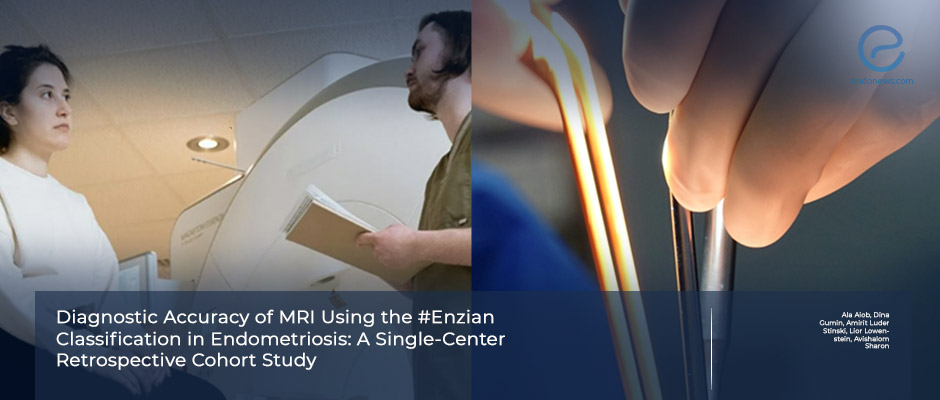Pelvic MRI May Support Laparoscopy in Endometriosis Management
Aug 8, 2025
Pelvic MRI with #Enzian aids surgery but can’t replace laparoscopy.
Key Points
Highlights:
- Pelvic MRI using the #Enzian classification showed variable accuracy depending on the anatomical site.
- Highest accuracy was in the tubo-ovarian region, rectovaginal septum, and ovaries; lowest in the parametrium and extragenital compartments.
- Older age, higher parity, and gastrointestinal symptoms correlated with improved MRI detection rates.
Importance:
-
While pelvic MRI can help map deep endometriosis for surgical planning, it cannot replace laparoscopy, the gold standard for comprehensive diagnosis and treatment.
What’s Done Here:
- A single-center, retrospective cohort study evaluated 24 women with suspected endometriosis who underwent both pelvic MRI and laparoscopy.
- MRI and surgical findings were compared using the #Enzian classification across 64 anatomical compartments.
Key Results:
- Correct lesion localization on MRI: 31.3% of compartments.
- Correct lesion size estimation: 20.3% of compartments.
- Best-performing sites: tubo-ovarian region (60%), rectovaginal septum (42.9%), ovaries (41.7%).
- Poorest performance: parametrium (7.1%); rectum, extragenital sites, bladder and ureter (0%).
- MRI accuracy improved with older age, higher gravidity/parity, and presence of soft or loose stools.
Limitations:
- The sample size was small, the study was a retrospective one, and the MRI scans were performed at different centers that had differing imaging quality and radiologist expertise.
From the Editor-in-Chief – EndoNews
"This study reinforces an important reality in endometriosis care: imaging, no matter how structured or sophisticated, still cannot replace direct surgical evaluation. The #Enzian classification provides a standardized, anatomically detailed framework that enhances communication between radiologists and surgeons, but its performance is uneven across pelvic compartments.
The findings—accurate lesion localization in only one-third of compartments and size estimation in one-fifth—highlight the persistent limitations of MRI, especially for superficial and parametrial disease. The correlation between higher accuracy and patient characteristics such as age, parity, and gastrointestinal symptoms is intriguing, but unlikely to offset the method’s inherent diagnostic gaps.
For clinicians, this means MRI with #Enzian scoring is best viewed as an adjunct for surgical planning, particularly in suspected deep infiltrating endometriosis, rather than a standalone diagnostic tool. Until imaging protocols and reader expertise become more uniform, laparoscopy remains indispensable for comprehensive mapping and treatment."
Lay Summary
Magnetic resonance imaging (MRI) using the Enzian classification system “offers a structured method” to test for deep infiltrating endometriosis (DIE), according to a new study published in the scientific journal Gynechologic and Obsteric Investigation. However, it has limited accuracy for peritoneal or parametrial lesions.
To test the accuracy of pelvic MRI interpreted using the Enzian classification system for the diagnosis of endometriosis, a team of researchers led by Dr. Avishalom Sharon from Azrieli Faculty of Medicine, Bar Ilan University in Safed and the Department of Obstetrics and Gynecology, Galilee Medical Center in Nahariya, Israel, conducted a retrospective observational study in 24 women, ages 19 to 49 who had a laparoscopy for endometriosis between 2016 and 2023. All patients also had a preoperative pelvic MRI available. Both MRI and surgical findings were categorized using the #Enzian system, which maps lesion location and size across defined pelvic compartments.
Overall, MRI correctly identified lesion location in 31.3% of anatomical compartments and lesion size in 20.3%.
The highest accuracy was in the tubo-ovarian region, followed by the rectovaginal septum and ovaries. In contrast, the parametrium, rectum, extragenital sites, bladder and ureter had very low or no detection rates.
Older age, previous pregnancies, and gastrointestinal symptoms were linked to better MRI accuracy.
While MRI can be a valuable tool for surgical planning—especially for deep infiltrating endometriosis—it remains less reliable for superficial or parametrial disease. Laparoscopy continues to be the gold standard for a complete diagnosis and treatment strategy.
Research Source: https://pubmed.ncbi.nlm.nih.gov/40555209/
deep infiltrating endometriosis DIE ENZIAN classification pelvic MRI laparoscopy diagnosis

